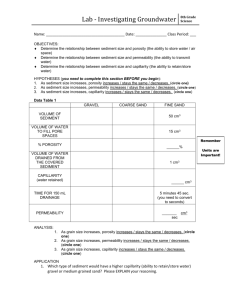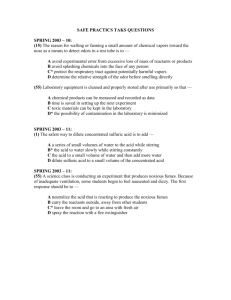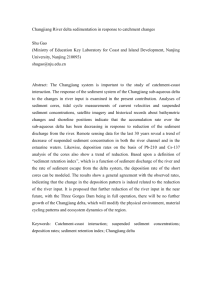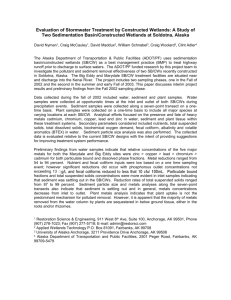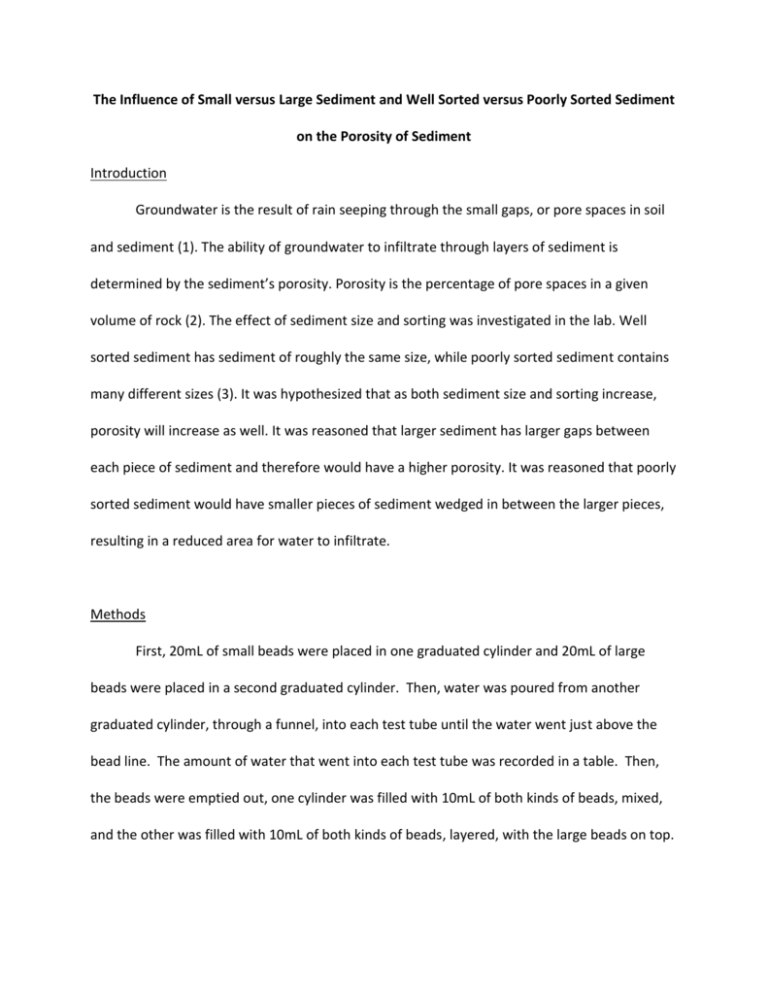
The Influence of Small versus Large Sediment and Well Sorted versus Poorly Sorted Sediment
on the Porosity of Sediment
Introduction
Groundwater is the result of rain seeping through the small gaps, or pore spaces in soil
and sediment (1). The ability of groundwater to infiltrate through layers of sediment is
determined by the sediment’s porosity. Porosity is the percentage of pore spaces in a given
volume of rock (2). The effect of sediment size and sorting was investigated in the lab. Well
sorted sediment has sediment of roughly the same size, while poorly sorted sediment contains
many different sizes (3). It was hypothesized that as both sediment size and sorting increase,
porosity will increase as well. It was reasoned that larger sediment has larger gaps between
each piece of sediment and therefore would have a higher porosity. It was reasoned that poorly
sorted sediment would have smaller pieces of sediment wedged in between the larger pieces,
resulting in a reduced area for water to infiltrate.
Methods
First, 20mL of small beads were placed in one graduated cylinder and 20mL of large
beads were placed in a second graduated cylinder. Then, water was poured from another
graduated cylinder, through a funnel, into each test tube until the water went just above the
bead line. The amount of water that went into each test tube was recorded in a table. Then,
the beads were emptied out, one cylinder was filled with 10mL of both kinds of beads, mixed,
and the other was filled with 10mL of both kinds of beads, layered, with the large beads on top.
Water was also poured through a funnel into these tubes until the water went above the bead
line, and the amount poured in was recorded.
Results
Figure 1: Shows the relationship between poorly sorted and well sorted sediment’s (bead’s)
porosity, and large and small sediment’s porosity.
Effect of Particle Sorting and Size on Porosity
50%
Porosity (%)
45%
40%
100% large beads
35%
100% small beads
30%
50% each, layered (well
sorted)
50% each, mixed (poorly
sorted)
25%
20%
15%
10%
5%
0%
Sorting
Size
Variable
Porosity Calculation:
-Measure water / measure beads = porosity
Example: Small bead porosity: 8/20 = 2/5= 40%
Figure and Calculation 2: Shows how size should have no affect on porosity
(Entire area is filled with
this size sediment)
16x
8x
8x
16x
(Entire area is filled with
this size sediment)
-There are two equal areas (128x²: 8x by 16x): one contains all small sediment (diameter = x)
and the other contains all large sediment (diameter = 2x)
Area of large sediment circles:
𝐴 = 𝜋𝑟 2
𝐴 = 𝜋𝑥 2 𝑥 32
𝐴 = 32𝜋𝑥 2
Pore Spaces = 128x² - 32𝜋𝑥 2
Area of small sediment circles:
𝐴 = 𝜋𝑟 2
Equal
1
2
𝐴 = 𝜋(2 𝑥) x 128
1
𝐴 = 𝜋(4 𝑥)2 x 128
𝐴 = 32𝜋𝑥 2
Pore Spaces = 128x² - 32𝜋𝑥 2
Pore Spaces = 128x² - 32𝜋𝑥 2
Discussion
Through analyzing the possible amounts of water added to different amounts and sizes
of beads, conclusions can be made about the porosity of different kinds of sediment. As Figure
1 shows, the graduated cylinder containing only small beads had a higher porosity than the
graduated cylinder with all large beads. However, research shows that this is incorrect when
applied to sediment in the ground; size should have no effect on porosity (1). Figure and
Calculation 2 also proves this point in a hypothetical situation where there are two equal areas.
One contains all of the same sized small beads, while the other has large beads of all the same
size. The amount of space not filled with the sediment was calculated to be the same in each
area, proving that size has no effect on porosity.
The experiment gave the opposite result of what should have happened because while
the water was poured into the graduated cylinder, it overflowed and a rough amount was
subtracted to make up for the error. This error could have been avoided if water displacement
was used. Water displacement is used when the amount of dry beads is measured first then
water is added so that it is a significant higher than the sediment. The amount of pore spaces
and porosity would then have been calculated by subtracting the dry bead measurement from
the water and beads together. That would provide more accurate results because overflowing
would not have been an issue, and there would be no question of where exactly the top of the
sediment was.
The hypothesis that as size increased, porosity would increase too was also incorrect.
The hypothesis was wrong because although it was correctly reasoned that larger sediment has
larger spaces between each piece, it was not thought of that smaller sediment would have
more spaces because more pieces fit into a given area. However, the hypothesis that predicted
how sorting would affect sediment porosity was correct, and supported by the data.
Figure 1 shows that the better sorted sediment had a higher porosity than the poorly
sorted sediment, as was predicted. The hypothesis rationale that the smaller sediment would fit
between the larger sediment in a poorly sorted arrangement and therefore have a lower
porosity was correct (1). However, this experiment could have also been improved by water
displacement because the measurements would have been more accurate, and a greater
difference than 10% may have been observed between the poorly sorted and well sorted
sediment.
Permeability is the ability of sediment to allow liquids to flow through the porous
spaces. The size of the pores would affect the permeability of a substance. Substances with
larger holes would most likely have a higher permeability because there is more space for water
or other liquids to pass through. Another factor that would affect the permeability of a
material is whether or not the spaces are already filled. For example, if extremely porous
sediment has its spaces filled with precipitated minerals, the sediment would not be
particularly permeable. Permeability and porosity are both important in understanding how
ground water will flow in a sample of sediment because the two work together. Sediment with
a low porosity will most likely not have a high permeability because there will not be a lot of
spaces for the liquid to move through. Also, if there are several different sediments with
different porosities, some low and some high, the direction of flow would be determined by
which sediment has the highest permeability.
One way to design an experiment to examine the relationship between size of sediment
and permeability could be to fill two fine-mesh colanders with a certain volume of sediment.
One colander would have large sediment and the other colander would have small sediment.
The colanders would be placed with funnels inside graduated cylinders underneath. A
designated amount of water would be poured into each of the colanders, and the amount of
water that flowed through the sediment would be measured in the graduated cylinder.
Presumably, the sediment size with the higher permeability would have more water in its test
tube because the water would have had an easier time flowing through it.
Appendix
Bead Combination
Measure of
Beads (mL)
Measure of Water added until reaching
top of sediment (mL)
100% small beads
20
8
100% large beads
50% each, mixed
(poor sorting)
50% each, layered
(sorting)
20
6
20
7
20
9
Porosity Calculations:
Small bead porosity: 8/20 = 2/5= 40%
Large bead porosity: 6/20 = 3/10= 30%
Mixed porosity: 7/20= 35%
Layered porosity: 9/20 = 45%
Bibliography
1. "Â ." What Is Groundwater? Web. 18 Mar. 2012.
<http://www.groundwater.org/kc/whatis.html>.
2. Tarbuck, Edward J., and Frederick K. Lutgens. Prentice Hall Earth Science: Physical
Setting, Earth Science. Boston, MA: Pearson/Prentice Hall, 2009. Print.
3. "Soil Properties That Affect Groundwater." Portage County, WI. Web. 18 Mar. 2012.
<http://www.co.portage.wi.us/groundwater/undrstnd/soil.htm>.


